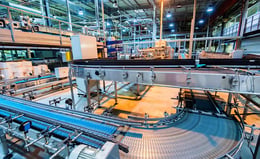Four Lessons for the Supply Chain from Auto Industry Leaders
Nancy Sarpolis - October 11, 2022

At a recent forum for automotive manufacturers and suppliers, participants discussed the trends and challenges facing the industry in 2022 and beyond. While their focus was on logistics, the key message for the rest of the supply chain was this: In today’s volatile environment, working across the enterprise is more important than ever.
It’s an especially pertinent message for those in the production environment who are starting their digital transformation journey. The ability to use Industry 4.0 tools to see beyond the factory floor can provide the edge manufacturers need to improve efficiency and productivity.
Here are more insights from the automotive forum:
Lesson #1: Networks need resilience to weather continuing uncertainty
The plans of automobile manufacturers—like those in other industries—are subject to numerous political, social, environmental and economic factors that cannot always be fully planned and predicted. Natural disasters, labor shortages, scarcity of steel and other raw materials, and political uncertainty are a few examples. Long-term and resilient planning is essential as auto industry insiders agree that supply chains will continue to experience more and more interruptions.
It's no longer enough to deliver products at the right time, the right quality, and at the best cost. Organizations now need networks with the resilience to tolerate shocks and the agility to respond to demanding customers and fast-changing markets.
Resilience in a supply chain is a critical component for success. The key to achieving resiliency is digitization, a process that entails converting the supply chain into an integrated sequence of planning and production solutions that work together. Connecting the data sources and outlets allows organizations faster data access, communication, and higher levels of transparency – all of which will better prepare the company to handle the unexpected.
Lesson #2: Transportation costs will influence sourcing decisions much more in the future
Many organizations do not understand the intricacies of transportation, and shipping is often an afterthought. Planning typically involves consolidating orders, sequencing trailer loading to maximize utilization, and selecting more economical transportation services. Most companies evaluate constraints and cost-saving opportunities for pending shipments, usually one to five days into the future.
But optimizing truck utilization offers enormous savings potential on logistics costs—and it can have a ripple effect throughout the supply chain. The general assumption is that S&OP drives transportation, so shipping operations exist to support it. But transportation forecasting tools that supplement traditional Transportation Management Systems can bridge the gap between S&OP and shipping. Translating demand to shipment forecasts makes collaboration with transportation providers possible, allowing time to secure sufficient capacity and better pricing.
Likewise, altering production and distribution schedules to take advantage of excess carrier capacity can lead to additional supply chain efficiencies. Integrating these functions enables the entire business enterprise process to align with shipping, removing a significant obstacle to supply chain optimization.
Lesson #3: Scenario planning leads to better decision-making
Industry 4.0 solutions that test a variety of scenarios to optimize the planning, scheduling, and monitoring of the whole supply chain—from distribution to production to transportation—are becoming must-haves in the supply chain management toolkit, according to automotive forum participants.
What-if analyses allow planners to change parameters and create different simulated scenarios. The effects of a change on production or distribution are calculated immediately and are made transparent, allowing the planner to determine the best course of action for each potential scenario.
Cloud-based APS solutions offer even more flexibility, letting supply chain planners manage capacity in a dynamic way or employ a central solution that interworks easily with MES and ERP systems. The ability to integrate with Microsoft Azure, AWS or popular suppliers of cloud services can also result in fast, simple, and scalable implementation across the organization.
Lesson #4: Greater focus on sustainability across the supply chain
It’s no secret that automotive companies—and organizations across multiple industries—are looking for ways to reduce their environmental impact as well as increase operational efficiency. The good news is, when companies optimize their operations, they can also achieve better environmental performance.
Through digital planning and sequencing tools, for example, organizations can align current production capabilities with projected sales, helping to reduce excess product and avoid shortages. Manufacturers will know how many materials they need, which equipment should be used, and the most optimal times to produce specific products. New incoming orders can also be optimally planned on a daily basis. Delayed raw material shipments and other bottlenecks are identified in real-time, allowing planners to adjust production programs and timetables. As a result, no materials, labor or energy are wasted.
These lessons from the automotive forum are applicable to all industries and provide a good roadmap for building the resiliency needed to meet the challenges of today—and the future.
If you want to learn more get your Guide to Production Planning
In this Guide you will learn:
-
How to build resilience
-
How to increase efficiency
-
How to use integrated APS planning services for production planning
-
What must-have features of an APS solution you need
-
Which KPI’s you can expect
LATEST POSTS
- Understand Circular Economy in The Manufacturing Industry
- How Can Industry 4.0 IT Integration Be Achieved Smoothly?
- The Significance of Order Sequencing in Discrete Manufacturing
- How to improve your Supply Chain Management: The Power of Control Towers
- Optimizing Human Resource Scheduling in Manufacturing: A Technological Approach



